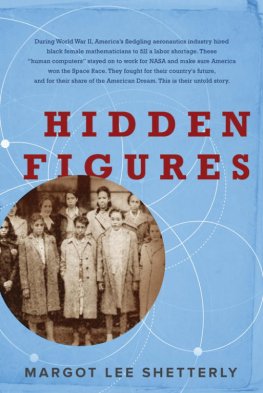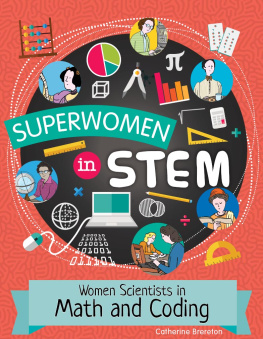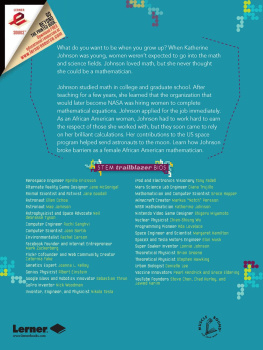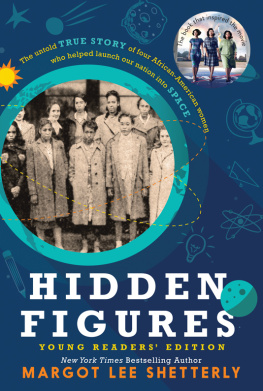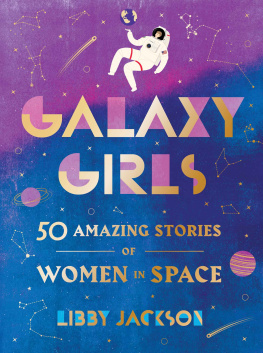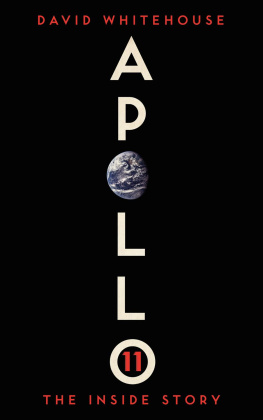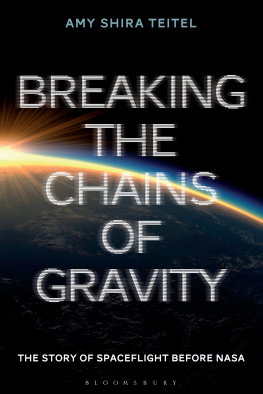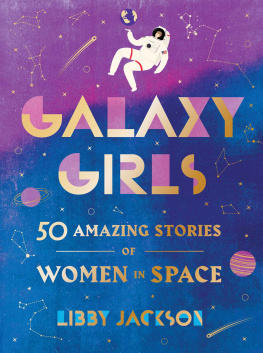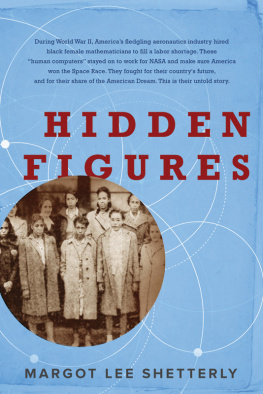Margot Lee Shetterly
HIDDEN FIGURES
The American Dream and the Untold Story of the Black Women Mathematicians Who Helped Win the Space Race

To my parents, Margaret G. Lee and Robert B. Lee III, and to all of the women at the NACA and NASA who offered their shoulders to stand on
Negro. Colored. Indian. Girls. Though some readers might find the language of Hidden Figures discordant to their modern ears, Ive made every attempt to remain true to the time period, and to the voices of the individuals represented in this story.
Mrs. Land worked as a computer out at Langley, my father said, taking a right turn out of the parking lot of First Baptist Church in Hampton, Virginia.
My husband and I visited my parents just after Christmas in 2010, enjoying a few days away from our full-time life and work in Mexico. They squired us around town in their twenty-year-old green minivan, my father driving, my mother in the front passenger seat, Aran and I buckled in behind like siblings. My father, gregarious as always, offered a stream of commentary that shifted fluidly from updates on the friends and neighbors wed bumped into around town to the weather forecast to elaborate discourses on the physics underlying his latest research as a sixty-six-year-old doctoral student at Hampton University. He enjoyed touring my Maine-born-and-raised husband through our neck of the woods and refreshing my connection with local life and history in the process.
During our time home, I spent afternoons with my mother catching matinees at the local cinema, while Aran tagged along with my father and his friends to Norfolk State University football games. We gorged on fried-fish sandwiches at hole-in-the-wall joints near Buckroe Beach, visited the Hampton University Museums Native American art collection, and haunted local antiques shops.
As a callow eighteen-year-old leaving for college, Id seen my hometown as a mere launching pad for a life in worldlier locales, a place to be from rather than a place to be. But years and miles away from home could never attenuate the citys hold on my identity, and the more I explored places and people far from Hampton, the more my status as one of its daughters came to mean to me.
That day after church, we spent a long while catching up with the formidable Mrs. Land, who had been one of my favorite Sunday school teachers. Kathaleen Land, a retired NASA mathematician, still lived on her own well into her nineties and never missed a Sunday at church. We said our good-byes to her and clambered into the minivan, off to a family brunch. A lot of the women around here, black and white, worked as computers, my father said, glancing at Aran in the rearview mirror but addressing us both. Kathryn Peddrew, Ophelia Taylor, Sue Wilder, he said, ticking off a few more names. And Katherine Johnson, who calculated the launch windows for the first astronauts.
The narrative triggered memories decades old, of spending a much-treasured day off from school at my fathers office at the National Aeronautics and Space Administrations Langley Research Center. I rode shotgun in our 1970s Pontiac, my brother, Ben, and sister Lauren in the back as our father drove the twenty minutes from our house, straight over the Virgil I. Grissom Bridge, down Mercury Boulevard, to the road that led to the NASA gate. Daddy flashed his badge, and we sailed through to a campus of perfectly straight parallel streets lined from one end to the other by unremarkable two-story redbrick buildings. Only the giant hypersonic wind tunnel complexa one-hundred-foot ridged silver sphere presiding over four sixty-foot smooth silver globesoffered visual evidence of the remarkable work occurring on an otherwise ordinary-looking campus.
Building 1236, my fathers daily destination, contained a byzantine complex of government-gray cubicles, perfumed with the grown-up smells of coffee and stale cigarette smoke. His engineering colleagues with their rumpled style and distracted manner seemed like exotic birds in a sanctuary. They gave us kids stacks of discarded 1114 continuous-form computer paper, printed on one side with cryptic arrays of numbers, the blank side a canvas for crayon masterpieces. Women occupied many of the cubicles; they answered phones and sat in front of typewriters, but they also made hieroglyphic marks on transparent slides and conferred with my father and other men in the office on the stacks of documents that littered their desks. That so many of them were African American, many of them my grandmothers age, struck me as simply a part of the natural order of things: growing up in Hampton, the face of science was brown like mine.
My dad joined Langley in 1964 as a coop student and retired in 2004 an internationally respected climate scientist. Five of my fathers seven siblings made their bones as engineers or technologists, and some of his best buddiesDavid Woods, Elijah Kent, Weldon Statoncarved out successful engineering careers at Langley. Our next-door neighbor taught physics at Hampton University. Our church abounded with mathematicians. Supersonics experts held leadership positions in my mothers sorority, and electrical engineers sat on the board of my parents college alumni associations. My aunt Julias husband, Charles Foxx, was the son of Ruth Bates Harris, a career civil servant and fierce advocate for the advancement of women and minorities; in 1974, NASA appointed her deputy assistant administrator, the highest-ranking woman at the agency. The community certainly included black English professors, like my mother, as well as black doctors and dentists, black mechanics, janitors, and contractors, black cobblers, wedding planners, real estate agents, and undertakers, several black lawyers, and a handful of black Mary Kay salespeople. As a child, however, I knew so many African Americans working in science, math, and engineering that I thought thats just what black folks did.
My father, growing up during segregation, experienced a different reality. Become a physical education teacher, my grandfather said in 1962 to his eighteen-year-old son, who was hell-bent on studying electrical engineering at historically black Norfolk State College.
In those days, college-educated African Americans with book smarts and common sense put their chips on teaching jobs or sought work at the post office. But my father, who built his first rocket in junior high metal shop class following the Sputnik launch in 1957, defied my grandfather and plunged full steam ahead into engineering. Of course, my grandfathers fears that it would be difficult for a black man to break into engineering werent unfounded. As late as 1970, just 1 percent of all American engineers were blacka number that doubled to a whopping 2 percent by 1984. Still, the federal government was the most reliable employer of African Americans in the sciences and technology: in 1984, 8.4 percent of NASAs engineers were black.
NASAs African American employees learned to navigate their way through the space agencys engineering culture, and their successes in turn afforded their children previously unimaginable access to American society. Growing up with white friends and attending integrated schools, I took much of the groundwork theyd laid for granted.
Every day I watched my father put on a suit and back out of the driveway to make the twenty-minute drive to Building 1236, demanding the best from himself in order to give his best to the space program and to his family. Working at Langley, my father secured my familys place in the comfortable middle class, and Langley became one of the anchors of our social life. Every summer, my siblings and I saved our allowances to buy tickets to ride ponies at the annual NASA carnival. Year after year, I confided my Christmas wish list to the NASA Santa at the Langley childrens Christmas party. For years, Ben, Lauren, and my youngest sister, Jocelyn, still a toddler, sat in the bleachers of the Langley Activities Building on Thursday nights, rooting for my dad and his NBA (NASA Basketball Association) team, the Stars. I was as much a product of NASA as the Moon landing.

